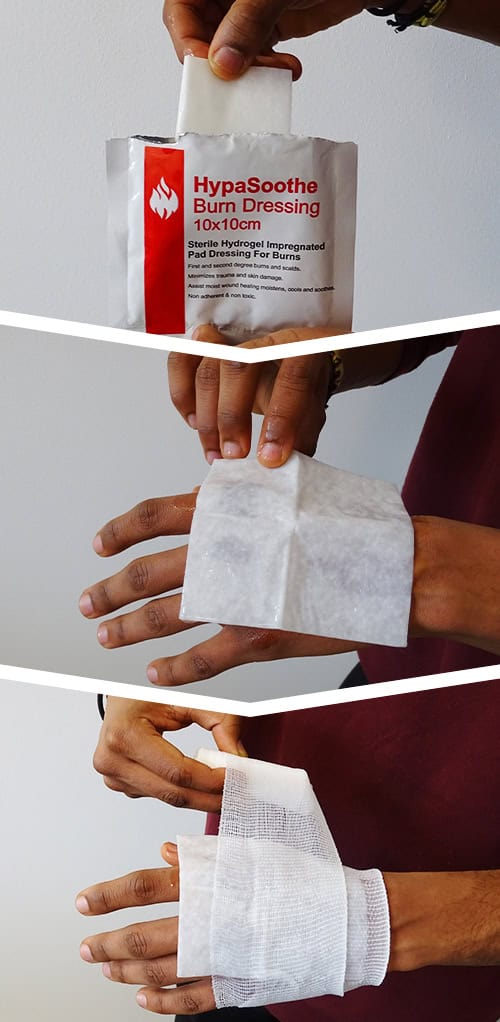
Low Adherent Dressings are a great addition to any first aid kit, specially designed not to stick to anything these dressings will reduce if not eliminate the pain associated with removing an adhesive dressing. This article will cover what a low adherent dressing is, what they should be used for and how to use them to protect sensitive wounds from infection.
What is a low adherent dressing?
Low adherent dressings are almost exclusively used with a secondary dressing or a bandage as its purpose is more to provide a clean and non-adhesive layer of protection to the wound, ensuring that stray strands of material or bacteria can not enter the wound.These dressings, like most other dressings, differ from bandages by being placed directly upon the wound. In fact, low adherent dressing pads, or non-adherent dressings, are specially designed, through the use of tulle as the primary component, so that they will not stick to either the wound or your skin, unlike adhesive dressings such as plasters. This results in less pain when the dressing is removed and reduces the risk of reopening the wound.
What are low adherent dressings used for?
Low adherent dressings are primarily used for minor injuries, such as superficial cuts, minor abrasions and lightly exuding wounds. They are also ideal for treating injuries like burns, where the skin is more fragile, due to their easy removal.Like other dressings, low adherent dressings are used to protect an injury from infection and further damage. They are particularly good at absorbing the excess exudate from a wound while it heals.
The best uses for low adherent dressings are:
- Burns
- Grazes
- Lightly exudating wounds
- Skin grafts
- Donor sites
- Post operative wounds
- Abrasions
- Small cuts
Low adherent dressings should not be used for:
- Heavily bleeding wounds – wounds like these would be better treated with a Haemostatic dressing that will quickly stop the blood loss.
- Infected wounds
- Large cuts

Types of low adherent dressing
Similar to plasters, Low adherent dressing comes in various different shapes and sizes, designed to fit a variety of wounds and can also be cut to size by sterile scissors if needed. They come as pads, strips or sheets to make it even easier for them to be applied to different areas of the body.Burns dressings
Burns dressings are a common type of low adherent dressing. This is because they do not have any adhesive materials, needing to be held in place by a bandage, and they are designed to not cause any further damage or trauma when they are removed.This type of dressing has been specifically designed for treating burns, allowing for rapid pain relief and cooling even when there is no sink with running water available. For example, our burns dressing are impregnated with a water-based gel formula to help reduce the pain and heat from the injury as quickly as possible.
Another reason burns dressings are useful is that they can be used on areas of the body that it is difficult to hold under water for prolonged periods of time, such as a face, back or chest. They also lessen the risk of hypothermia in a burn patient.
Gauze dressings
Gauze dressings could potentially be viewed as another type of low adherent dressing as they need to be held in place by something else to prevent them from falling off. However, they aren’t advisable for heavily bleeding or exudating wounds as they can get caught and stick to the wound bed.Gauze is a great supply to use for cleaning a wound as well, for example our Gauze swabs are made from highly absorbent cotton to comfortably prepare the wound for dressing or provide a soft cushion for the injury.
How to use low adherent dressing correctly
It may be slightly more challenging to apply low adherent dressing to your own wounds than adhesive dressings depending on where the injury is located. But overall, it is fairly simple to use a low adherent dressing correctly.As a low adherent dressing will be applied directly to a wound it is imperative that the dressing is sterile. This is to prevent infection and contamination to the injury from anything that may have attached itself to the dressing if the packaging had been opened previously.
Applying low adherent dressing
- Wash your hands or put on clean gloves so as not to contaminate the injury.
- Clean or irrigate the wound so that there are no contaminants left before the application of the dressing.
- Place the dressing on the wound, the ‘shiny’ film side facing towards the injury.
- Secure the dressing using either microporous tape or a bandage.
Changing a low adherent dressing
- Wash your hands or put on clean gloves, just as you would when applying the dressing for the first time.
- Slowly remove what is holding the low adherent dressing in place. Then remove the dressing itself. Dispose of these appropriately.
- Ensure the wound remains clean, otherwise it could easily get infected.
- Place a new dressing on the wound, making sure to have it the correct way round.
- Finally, resecure the low adherent dressing in place with either more tape or a bandage.
As the process for apply wound dressings can sometimes vary slightly depending upon the type of dressing that is being used, you should read How to Apply, Change and Use Different Wound Dressings to ensure you understand the different methods.
Why use low adherent dressing?
Low adherent dressing is the perfect solution for wound care if you have a minor injury surrounded by sensitive skin or a burn that requires covering. This is because they do not contain any adhesive they will not stick to skin or itself so will provide a protective barrier above the wound without further aggravating it.Read our other blogs for more information on first aid or contact us for further advice and information on our products.
By Sarah Mason

